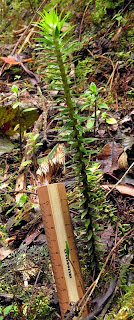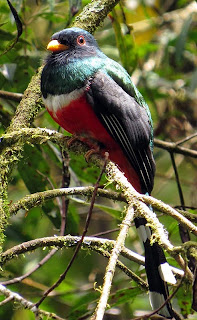This is the
second blog in a series from my recent private tour to SE Peru, starting with this post.
As our first
full day in the field, including a long morning and an additional short
afternoon on the trails, this will be a very photo-heavy blog. We were at
Wayqecha Biological Station, a wonderful place to stay at about 9800 feet (3000
m) elevation.
This morning
Susanne and I decided to walk one of the longer and more difficult trails, something
I don’t get to do when leader larger birding groups here. So after breakfast we
set off down the Picaflor Trail, which heads quite steeply down the slopes
below the lodge, and intended on catching the Oso Trail which ends at the
Esperanza station where the researchers stay. We were soon surprised by a flock
of about 20 twittering Andean Parakeets that flushed from some fruiting bushes
and perched in the treetops. I’ve rarely had a chance to see them so well.
This Masked
Flowerpiercer is a very common bird in the rather stunted woodland that grows
on the poor soils of this particular slope.
The
Scarlet-breasted Mountain-Tanager is also one of the most common species here, usually
in flocks and sometimes just in pairs, but they are found in almost any type of
high-elevation forest.
Much more limited
to the scrubbier habitat is the Rufous-capped Thornbill, but it’s still a
common hummingbird in this area; I’m not sure there are many other places where
it so easily seen, though it is still outnumbered by the abundant Tyrian
Metaltail and Shining Sunbeam.
This terrestrial
orchid, Epidendrum secundum, is
commonly seen on these sunnier slopes.
After many
steep switchbacks and numerous stops for birds and plants, it became clear that
we weren’t going to have time to hike the entire Oso Trail, so we turned back
and followed the much easier Zorro Trail, eventually entering a taller, moister
forest and still ending up at Esperanza. Here we found many mushrooms, which Susanne
was so hoping to see. I didn’t take many pictures of them (just wait…), but I
did find this tiny Favolaschia-like
species quite adorable. The honeycomb-like structure to the underside, where
many mushrooms have gills (the hymenium), was not something I’ve noticed before
– but then I’ve only rarely turned over mushrooms.
More
intriguing were these apparent fungal balls growing on Chusquea bamboo stalks.
Even Susanne had no idea what it was.
The plant
life in this much moister environment was fabulous. This single stalk of what I
think was a true moss was nearly a foot tall (those are centimeters on the
ruler).
The
varieties of lichens seemed endless, many of them quite lush and beautiful.
I’ve read
that over 200 species of orchids are known from here, but we saw “only“ perhaps
about 10-15. This one is Neodryas
rhodoneura.
Another very
showy one is this Odontoglossum auroincarum lasserum. Thanks to Guido Deburghgraeve at Flickr for correcting the name of this orchid.
Some have
really tiny and relatively uninteresting flowers but fascinating plant forms,
such as this Pachyphyllum species.
Some have
tiny yet still exquisite flowers. This may also be a Pachyphyllum.
This tiny
green orchid is possibly in the genus Stelis.
We saw
several birds that prefer this taller forest, including this Masked Trogon that
was nesting in a cavity only waist-high, right next to the trail. I had walked
right past it, noticing only the trail cam opposite it. Then it suddenly burst
out of the tree cavity right between Susanne and me, eliciting a yelp of
surprise from her.
In trying to
attract a mixed flock of tanagers, warblers, and tyrannulets, I whistled like a
Yungas Pygmy-Owl, and soon I had attracted the genuine article.
We
frequently heard the distinctive sound of what I call the Acjanaco Andes-Frog (Psychrophrynella usurpator), but I’ve
still never seen one.
So when I
saw this frog hopping on the trail, I thought I might have one. But thanks to
photo sheets published by the Field Museum I was able to identify this tiny
thing as Pristimantis pharangobates.
Perhaps it’s the other frog sound we heard, the occasional single click.
This is a
weevil, probably a broad-nosed weevil in the subfamily Entiminae.
This is a
leaf beetle, family Chrysomelidae.
This lovely,
golden scarab looks surprisingly similar to a North American beetle in the
genus Cotalpa but is probably
something quite different, perhaps Platycoelia.
Cicadas are
more typical of the warmer low elevations, but there are some up here too, though
I’ve rarely seen them and hear them only when its sunny. This one was caught by
a strand of spider web not far up a tree, so I was able to grab it for
inspection. Its much furrier body and stouter, more compact shape than lowland
species (less surface area for its size) are clearly both adaptations to the
cool, moist environment.
It was sunny
almost all day, rare at this location, especially since we should be well into
the start of the rainy season, when afternoon cloud buildup and rain should be
a daily thing. The most unusual lepidopteran we saw was this skipper, whose
true identity is still unknown; there are very few skippers at this elevation, where the convergence of sunny skies and the presence of lepidopterists is an exceptionally rare event.
This satyr is
a Pale Lyman, Lymanopoda eubagioides.
This one breaks the thermoregulation rule of most high-elevation butterflies,
which are dark brown to even black in order to absorb solar radiation more
effectively.
This is a
more typically colored satyr. It was discovered here only relatively recently
and is still known only as Eretris sp.
nov.
This Blue
Jewel, Perisama philinus, is one of
many in the genus that have an underside that bears no resemblance to the top.
When it’s sunny, it opens its wings to get warm.
Flitting in
the shady edges above the sunny roadside after we had reached end of the trail,
this moth in the genus Erateina looks
deceptively like a butterfly.
This
gorgeous caterpillar was sitting still on a leaf in the forest understory; it’s
certainly a moth, but I’d have no idea what family to start with.
Of course, I
can barely help myself when it comes to the amazing blooming plants here. This Tibouchina species was irresistible,
though it pales in comparison to the ones I’ll see on my SE Brazil tour next November.
This shrub Bejaria aestuans was a new ID for me (thanks again to Field Museum photo sheets),
though I had seen it before; it’s a rather atypical member of the family
Ericaceae, most of which have fused petals in bell-shaped flowers.
In the late
afternoon we hiked the trail to the hanging bridges in the gorgeous cloud
forest. Here I am looking down on one of the many species of tree fern in the
region.
Looking up
from the same vantage point, one sees a distant hillside of puna grassland
glowing in the afternoon sun.
Then after
dark there’s always the moth show at the lights – better when there is some overcast
or fog and a new moon. It was mostly clear with a waxing moon, but I still saw
a few nice things.
Two noctuids:
Update: Thanks to my friend Jeremy Gatten to pointing me towards the family Drepanidae (which I barely know), subfamily Thyatirinae. This is most likely the widespread Thyatira mexicana, known even from SE Arizona.
Two epiplemids:
And a
handsome tiger moth I hadn’t seen before (family Erebidae but in the
distinctive subfamily Arctiinae). Update: this is Elysius terra.
There were also
some large beetles attracted to the lights. This rhinoceros beetle is not such
a straightforward ID as it would first seem; tribe Oryctini is about as close
as I can get for now.
This amazing
thing is a female stag beetle (family Lucanidae), Sphaenognathus giganteus. Thanks to my friend Margarethe
Brummermann who knew the species.
Yes,
Wayqecha is a wonderful location. My blog doesn’t even come close to showing
you what it’s like to be there, but this video from the non-profit that owns it
gives you a better feel for it.
http://vimeo.com/106402341















































No comments:
Post a Comment